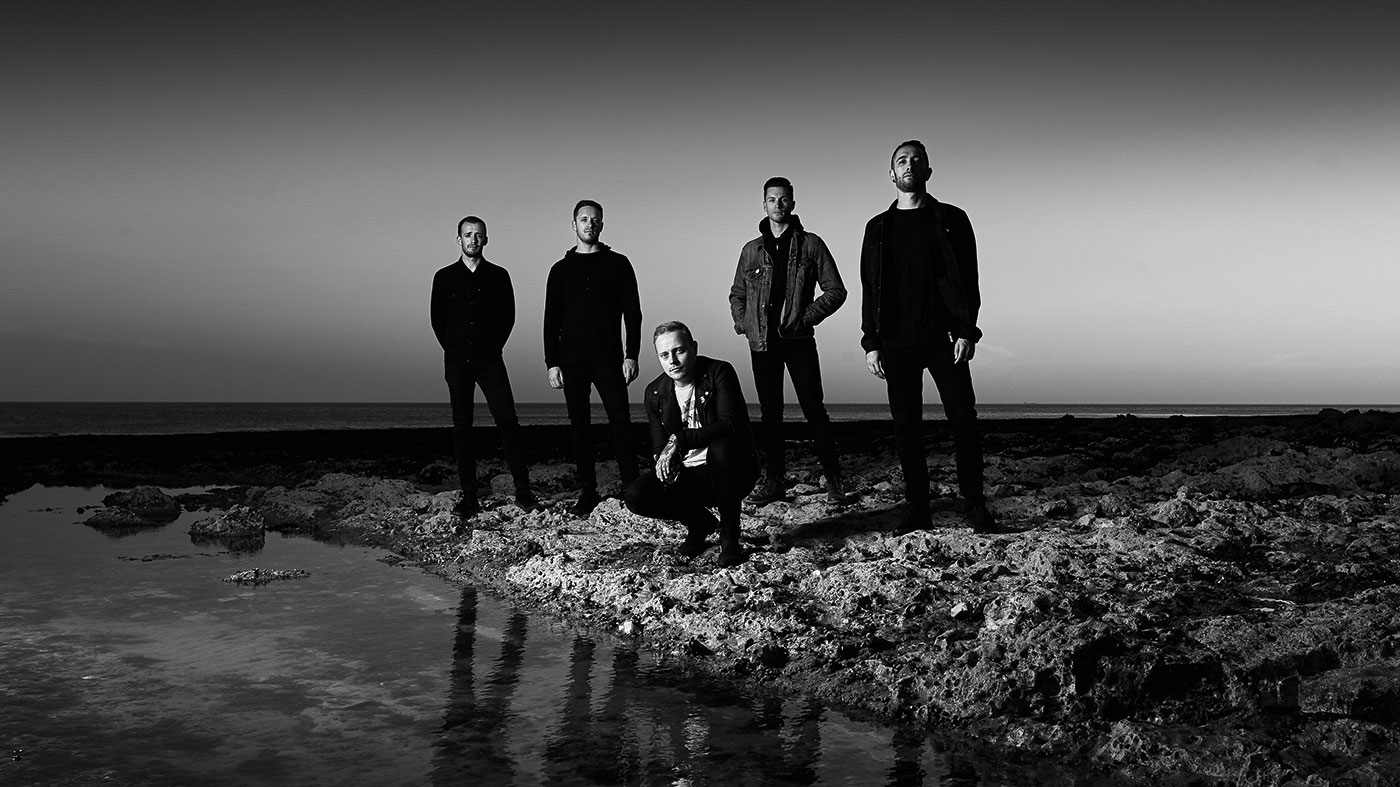Architects: “Tom is there throughout the album in ambient tracks, clean parts and more”
Josh Middleton and Adam Christianson talk Tom Searle's legacy, precision riffing and Holy Hell

Architects guitarists Josh Middleton and Adam Christianson pay tribute to founding member Tom Searle and reveal the story behind landmark new album Holy Hell…
When we last caught up with Brighton metallers Architects on a sunny afternoon in April 2016, founding brothers Tom and Dan Searle explained how it was a mutual love for music that spurred each other on and eventually became the foundation for the band they started over a decade prior.
It very much felt like the twins were a walking definition of musical telepathy, while also light-heartedly playing up to sibling rivalries in the accompanying photoshoot that celebrated seventh full-length, All Our Gods Have Abandoned Us. Only months later, it was announced guitarist Tom had passed away at the age of 28 following a three-year fight with cancer. It was a devastating loss that shook the metal community to its core.
“I don’t know what will become of Architects,” Dan admitted in the band’s announcement, adding: “Me and Tom started playing in a band together when we were 13 and Architects is just an evolution of the band that we started over half my life ago.”
Two years on and having fulfilled touring commitments with the band, Sylosis leader and Tom’s friend Josh Middleton is now with Architects on a full-term basis and worked closely with Dan for new effort, Holy Hell. It’s a huge achievement for a number of reasons and, as Josh and fellow guitarist Adam Christianson explain, an album born of love, loss and respect.
Building on a blueprint
What were the biggest challenges in deciding to carry on as a band?
Adam: “We wanted to stay true to the original sound, but also be a bit free with it and try new things, not feeling limited to working in a certain way. Obviously, there was a lot of pressure because of the situation, but there was also not a lot of pressure in the sense that we had no deadlines.
Get the MusicRadar Newsletter
Want all the hottest music and gear news, reviews, deals, features and more, direct to your inbox? Sign up here.
“There was no expectation, no one really knew what we were up to, we just thought we’d work on this music and see what happens. We could go at our own pace. There were a couple of tracks Tom had finished or partially finished that were like a springboard to work from and get a flavour of the album with.”
I filled in intermittently over the years and actually so did Adam before he fully joined
Josh: “A lot of all that perseverance was down to Dan. For us, it was more about getting our heads down and getting to work. Admittedly, we got started quite quickly with writing, but like Adam said, without telling anyone. We didn’t even tell the label when we were going to the studio, it was only much later when we needed to book it, we knew it was time to say, ‘There’s an album ready.’”
Josh, considering you’d known the band for a long time - having even filled in on guitar for tours - did that make the process of joining full-time any easier?
Josh: “I filled in intermittently over the years and actually so did Adam before he fully joined. I did a summer of festivals in 2012, then Adam played with them, then I did the following year’s festivals and then Adam joined. I’ve known the band since 2004 when they had a two-track EP and they stayed at my parent’s house when they recorded [second album] Ruin. We go way back.
“It wasn’t like we had to get to know each other; we’ve all stayed close, which made it an easier transition. I got on straight away with Adam - being guitarists, we always find a way to talk shop… it didn’t take long at all.”
Adam: “It felt pretty easy for us to lock in quickly. We have similar interests outside of the band, like [vegan] food. We don’t drink, so we’ll hang out on the bus with some muesli talking about weird conspiracy stuff. We’re the chilled-out guys for sure.”

Unleash the Kraken
What gear did you use on Holy Hell?
Josh: “I used an LTD for a lot of it with Fishman Fluence Modern pickups, which have no coils - they’re digital. There are some Kemper tracks, but most of it is a block letter 5150 through an old Mesa-Boogie cab when the speakers were being made in the UK, which sounds very different to the Chinese ones. I think Celestion try and deny it, but they sound super different. The sticker they put on is at a different angle!
There were four tracks for rhythms, so two tracks with the 5150 left and right and same again with the Kraken
“There was a Victory Kraken in there too as the KSR we originally tried wasn’t doing it. And in front of the amps, we always had a stock Maxon Tube Screamer or a TS9. There were four tracks for rhythms, so two tracks with the 5150 left and right and same again with the Kraken. Everything was going through the same cab and overdrive pedal. Our strings are low [B-tuned] and heavy gauge.”
And Tom’s parts from demoes were also included on the album too?
Josh: “There are a lot of his tracks in there as well. Two of the songs he had completely finished - though we’ll probably avoid going into full detail of who wrote what. Then there are a few songs where me and Dan elaborated stuff Tom had been working on. We had his computer with all these demos, some of those tracks ended up as the final guitar tracks on the album.
“There’s a lot of ambience you’ll hear that’s Tom actually playing. He’s not on every track, but he’s there throughout the album in ambient tracks, clean parts and more. Wherever possible, we would try to take the exact file from his demo in the final album.”
Adam: “They sounded cool and were difficult to recreate too; they worked as they are. It’s hard to say where they are most prominent, it’s just all sprinkled everywhere…”
When Tom last spoke to us, he declared his love for Strymon pedals, which must have played a part in those ambient noises...
Adam: “Yeah, he loved the BigSky and TimeLine for those pad-like guitar sounds. You can get a lot of mileage out of the ambiences, they can imply chord changes or add more mood to aggressive chugging. They can add movement and depth to your ideas.”
Josh: “Weirdly enough, we played Graspop Festival last year and the keyboard player from Deep Purple wanted to meet the band. He came into our dressing room asking what keyboards we had on the last album. And we told him, ‘None!’ He assumed all the ethereal ambient sounds were synth pads, when it was really Tom playing super-wet on a Strymon. I’ve always tried to experiment with ambience myself, layering up completely wet guitars in the background of songs so that they almost sound like keys.”
Until it clicks
My school for rhythm guitar was ...And Justice For All by Metallica
There’s a very rhythmic approach to guitar too, what exercises can readers learn to help?
Josh: “Practising to a click is essential. You have to do that, at the very least because playing with people is harder! Some have a tendency to speed up; other musicians have a tendency to play behind the beat. If you can’t do a click, you are going to really struggle with humans. I see comments online on guitar videos where people write, ‘I tried playing with a click and didn’t like it’ or ‘couldn’t get on with it!’ and I always think, ‘But you have to!’ It’s boring but there are no shortcuts when it comes to that stuff.
“These days, everything is 4/4 with us, we don’t do much odd-meter stuff. My school for rhythm guitar was ...And Justice For All by Metallica. Learning Battery played a big part too, getting those gallop rhythms as tight as possible was huge. It’s probably the best rhythm exercise out there! Start slow for endurance and avoid going too fast too early, you’ll stress yourself and cramp out.
“I used to teach and people would always want to improve too quickly. You need to get it in your muscle memory, clean and tight at speeds you can maintain. Once you’ve gotten used to it, your muscles kick in and that’s when you bring in the metronome. People that want to play fast quickly - you’ll get there quicker, cleaner and better if you start slower.”

Sound and speed
And then, of course, there’s the actual tone of what you play…
Adam: “Exactly. People also forget about that side. Get the sound good first, before you think about speed. You need the right attack and percussion. I started out on music that wasn’t anywhere near as heavy, I used to be a pop-punk kid, which was all downpicking… it really isn’t that different to thrash! There are some great guitarists on the punk scene - NoFx are super crisp and tight every time you see them. Propagandhi too.
“On a similar note, I think people will find more improvement if they stop overdoing the gain. You want to underplay the gain, so everything is clear - you’re not trying to mask what you are doing, you want the ultimate attack. Less is more. You want the gain to come from your hands, rather than how much gain you have dialled in on the amp. You want the upstrokes to sound like the downstrokes. You don’t want two different sounds; it has to be in unison tonally.
“That’s why recording is one of the best ways of practising… there’s no way of hiding those mistakes. That is what you sound like. You might realise you are not as good as you thought, so you can put things under the microscope and get working on them.”
How do you hold the pick in order to execute those ultra-precise rhythms?
Josh: “I pick from the wrist… all the other styles like circular picking with your thumb and index finger don’t translate to metal riffing, at least in my experience. A solid wrist movement with thick picks works better. You want to be very assertive and percussive. You want to dig in, basically.
“Circular picking styles might be better for lead playing and economy stuff , but with metal rhythms, you want to be consistent and sound aggressive. It’s all about that one motion. Like Adam said, a lot of pop-punk bands are great at it… that dude from Pennywise down-picks like crazy! They might not be as tight live, but it’s a huge part of the sound.
“Back in the day, all the bands were going onto tape. Those classic Metallica records sound super-tight because there was no getting around it back then. There was no punching in. They had to learn how to play the entire song perfectly without any unwanted fret noises. The only way James Hetfield could record albums that tight was by practising how to play like that. Don’t rely on cutting stuff up on Pro Tools. Play songs the whole way through and listen back with a critical ear.”

Holy divers
There are also some pretty nifty pre-bends incorporated into a few of the riffs heard on Holy Hell...
Josh: “There’s definitely a few… I’m glad someone finally noticed! I’ve seen a few people playing Hereafter wrong on their YouTube cover videos. No one seems to have picked up on the pre-bend in the riff. Another really noticeable thing Tom used to do was on the song A Match Made In Heaven, which had a behind-the-nut bend that released back into open. It was just all the little things like that he did that were really cool. I love weird guitar effects like the Gojira scrape… I always call it the cat scrapper!”
That’s one skill not enough guitarists work on: just bending in tune. Guthrie Govan is incredible for that, he can play a scale off one fret almost
Adam: “That’s one skill not enough guitarists work on: just bending in tune. Guthrie Govan is incredible for that, he can play a scale off one fret almost. That’s an important thing, having muscle memory and the ear to adjust as you go.”
Those guitar tricks are often harder than they look to execute note-perfect.
Adam: “Being able to replicate sound effects every night is an unusual skill but it’s important. Players shouldn’t use noise gates as a crutch. Sure, they are there to make your playing better, but you should be able to play quietly without that stuff . Work on it with your hands first and then get rid of the feedback or noise that’s impossible to avoid. Doing it yourself the best you can first and then use the gear after that. A lot of players have their gain on full, their gate on full and that doesn’t sound as good.”
Josh: “If your noise gate is set high, those pick scrapes might not come all through in the same way. You have to practice them just like everything else, which is crazy.”
Adam, what are the main differences with Josh on the other side of the stage?
Adam: “Lots...”
Josh: “I’m trying not to change things, sorry to answer for Adam here!”
Adam: “Yeah, but you’re also your own guy. I would say you’re a more regimented player and very precise, in a good way, not a bad way. Josh is bringing years of experience and practice into this new thing.”
Josh: “Thank you, I’ll take that in a good way regardless ha ha! To be honest, I’ve been more into the idea of adapting into the band than bringing anything into the band. That would have been a different mentality I think. I’ve always focussed on rhythm a lot. That’s always been my main thing and Architects is pretty much all rhythm. Tom did some leads, obviously, but mostly rhythm.”
Finally, two years on… what do you most miss about Tom?
Josh: “His sense of humour. He was so funny… and extremely intelligent as well. I would always be excited to hang out with him. It sounds corny but I genuinely felt like I would take something back from any conversation with him, as in learn something new. I’m not really into small talk and I always felt he was one of those people where you could jump into something really in-depth within a minute of seeing him after having not for a few months.”
Adam: “He was one of the most unique people I’ve ever met and extremely insightful in so many different ways. We all miss him greatly.”
Holy Hell is out now on Epitaph.
Amit has been writing for titles like Total Guitar, MusicRadar and Guitar World for over a decade and counts Richie Kotzen, Guthrie Govan and Jeff Beck among his primary influences. He's interviewed everyone from Ozzy Osbourne and Lemmy to Slash and Jimmy Page, and once even traded solos with a member of Slayer on a track released internationally. As a session guitarist, he's played alongside members of Judas Priest and Uriah Heep in London ensemble Metalworks, as well as handling lead guitars for legends like Glen Matlock (Sex Pistols, The Faces) and Stu Hamm (Steve Vai, Joe Satriani, G3).
"At first the tension was unbelievable. Johnny was really cold, Dee Dee was OK but Joey was a sweetheart": The story of the Ramones' recording of Baby I Love You
"Reggae is more freeform than the blues. But more important, reggae is for everyone": Bob Marley and the Wailers' Catch a Fire, track-by-track






![PRS Archon Classic and Mark Tremonti MT 15 v2: the newly redesigned tube amps offer a host of new features and tones, with the Alter Bridge guitarist's new lunchbox head [right] featuring the Overdrive channel from his MT 100 head, and there's a half-power switch, too.](https://cdn.mos.cms.futurecdn.net/FD37q5pRLCQDhCpT8y94Zi.jpg)





